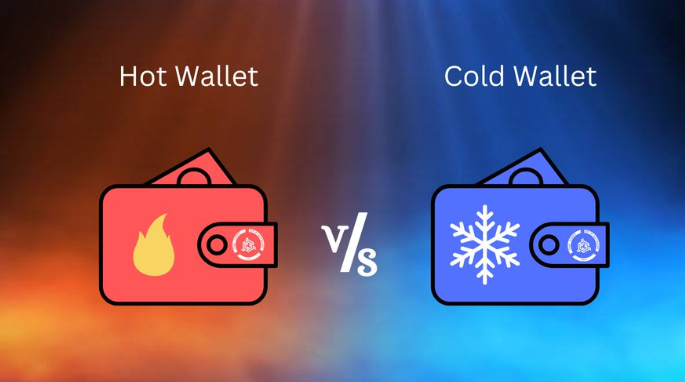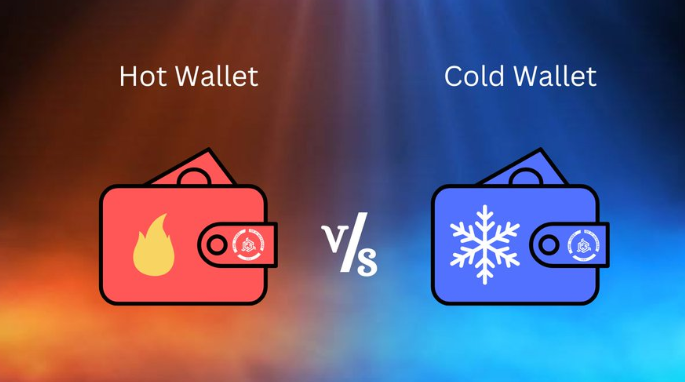Securing your cryptocurrency in 2025 remains a critical concern, especially with the evolving landscape of cyber threats and technological advancements. The fundamental choice between cold wallets and hot wallets persists, each offering distinct advantages and disadvantages in terms of security and convenience. Many users find a hybrid approach, leveraging both, to be the most effective strategy.
Cold Wallets: The Gold Standard for Security

Cold wallets, also known as hardware wallets or offline wallets, store your cryptocurrency’s private keys entirely offline, meaning they are never connected to the internet. This air-gapped nature makes them significantly more resistant to online threats like hacking, malware, and phishing attacks. They are widely considered the most secure option for long-term storage of significant cryptocurrency holdings.
Types of Cold Wallets:
- Hardware Wallets: These are physical devices that resemble USB drives (e.g., Ledger, Trezor) or credit cards (e.g., Tangem). They are designed to isolate your private keys from your internet-connected devices. Transactions are typically initiated on a computer or mobile device, then signed and approved on the hardware wallet itself before being broadcast to the network.
- Pros:
- Superior Security: Private keys are never exposed to the internet, significantly reducing hacking risks.
- Portability: Easy to carry and store.
- Tamper-proof features: Many include secure element chips and designs that make physical tampering evident.
- PIN protection and optional passphrases: Adds layers of security against unauthorized access if the device is lost or stolen.
- Multi-currency support: Most support a wide range of cryptocurrencies.
- Cons:
- Less Convenient: Requires more steps to initiate transactions compared to hot wallets.
- Cost: Hardware wallets typically cost money.
- Physical Loss/Damage: If the device is lost, stolen, or damaged, you could lose access to your funds if you don’t have a secure backup of your recovery phrase (seed phrase).
- Firmware Updates: May require manual firmware updates, which need to be performed carefully.
- Pros:
- Paper Wallets: This involves printing or writing down your private keys and public addresses on a piece of paper.
- Pros:
- Completely Offline: No electronic connection, making it immune to online hacks.
- Free: Costs nothing to create.
- Cons:
- Vulnerable to Physical Damage: Susceptible to fire, water, tearing, or simply being misplaced.
- Difficult to Use: Not practical for frequent transactions.
- Security Risk: If the paper is found by someone else, your funds are completely exposed.
- Deprecated: Generally not recommended for new users due to the high risk of human error and physical vulnerability.
- Pros:
- Air-Gapped Devices: Some advanced cold wallets never connect to the internet. Transactions are initiated online, details are exported (e.g., via QR code or USB), verified on the offline device, and then the signed transaction is re-imported to an online device to be broadcast. This offers an even higher level of isolation.
Key Security Considerations for Cold Wallets in 2025:
- Secure your recovery phrase (seed phrase): This is the master key to your funds. Write it down accurately and store it in multiple secure, offline locations (e.g., a fireproof safe, a safe deposit box). Never store it digitally or share it with anyone.
- Beware of counterfeit devices: Purchase hardware wallets directly from the manufacturer or authorized resellers to avoid compromised devices.
- Regularly check for firmware updates: While offline, some hardware wallets require occasional updates to patch vulnerabilities or add new features. Follow official instructions carefully.
- Physical security: Protect your hardware wallet from theft, loss, or damage.
Hot Wallets: Convenience with Compromises
Hot wallets are cryptocurrency wallets that are connected to the internet. They offer convenience for active trading and frequent transactions but inherently carry higher security risks due to their online exposure.
Types of Hot Wallets:
- Web Wallets: Accessed through a web browser (e.g., exchange wallets like Binance, Coinbase)
- Mobile Wallets: Applications downloaded on smartphones (e.g., Trust Wallet, Exodus).
- Desktop Wallets: Software installed on a computer (e.g., Exodus, Electrum).
Pros of Hot Wallets:
- Convenience: Easy and fast for sending, receiving, and trading cryptocurrency.
- Accessibility: Accessible from anywhere with an internet connection.
- User-Friendly: Often have intuitive interfaces, making them suitable for beginners.
- Often Free: Most software and web wallets are free to use.
Cons of Hot Wallets:
- Higher Security Risk: Constant internet connection makes them vulnerable to various cyber threats:
- Hacking: Exploits of software vulnerabilities.
- Phishing: Scammers tricking users into revealing private keys or login details.
- Malware: Malicious software that can steal information from your device.
- SIM Swap Attacks: Hackers gaining control of your phone number to intercept 2FA codes.
- Custodial vs. Non-Custodial:
- Custodial Wallets (e.g., exchange wallets): The exchange holds your private keys. While convenient, you don’t have full control over your funds, and you’re reliant on the exchange’s security measures. If the exchange is hacked or goes bankrupt, your funds could be at risk.
- Non-Custodial Wallets (e.g., MetaMask, Trust Wallet): You hold your own private keys, giving you full control. This means you are solely responsible for securing your seed phrase.
Key Security Considerations for Hot Wallets in 2025:
- Strong, Unique Passwords: Use complex, unique passwords for every crypto-related account and wallet. Consider using a reputable password manager.
- Enable Two-Factor Authentication (2FA): Always enable 2FA on all your crypto accounts (exchanges, wallets). Use authenticator apps (like Google Authenticator or Authy) rather than SMS-based 2FA, which is more susceptible to SIM swap attacks.
- Beware of Phishing and Scams:
- Verify URLs: Always double-check the website URL before entering login details. Scammers create fake websites that look identical to legitimate ones.
- Suspicious Emails/Messages: Never click on suspicious links or attachments. Verify the sender’s email domain.
- Social Engineering: Be wary of anyone asking for your private keys, seed phrase, or promising unrealistic returns.
- Keep Software Updated: Regularly update your wallet software, operating system, and antivirus programs to patch vulnerabilities.
- Use Secure Networks: Avoid accessing your crypto wallets on public Wi-Fi networks. Use a secure private network or a VPN.
- Be cautious with dApps and smart contracts: When interacting with decentralized applications (dApps) or new smart contracts, understand the risks involved. Revoke unnecessary token permissions regularly.
A Hybrid Approach: The Best of Both Worlds
For most cryptocurrency users, the most secure and practical approach in 2025 is a hybrid strategy:
- Cold Storage for the Bulk: Keep the majority of your cryptocurrency holdings in a cold wallet (preferably a hardware wallet) for long-term safekeeping. This significantly reduces the risk of major loss due to online attacks.
- Hot Wallet for Active Use: Keep a smaller amount of cryptocurrency in a hot wallet for daily transactions, active trading, or interacting with DeFi applications. This provides convenience without putting all your assets at risk.
Emerging Security Technologies and Trends in 2025
The crypto security landscape is constantly evolving. In 2025, several trends and technologies are further enhancing security:
- AI in Blockchain Security: AI is being leveraged for advanced anomaly detection, identifying unusual patterns that could indicate fraud or breaches. It can also help optimize consensus mechanisms and detect vulnerabilities in smart contracts.
- Multi-Party Computation (MPC) and Threshold Signatures: These technologies distribute control of private keys across multiple parties or devices, eliminating a single point of failure and enhancing security, especially for institutional investors and custodians.
- Quantum Computing Threats (Long-term Horizon): While not an immediate threat for most users in 2025, the potential for quantum computers to break current cryptographic standards is a long-term concern. Research into quantum-resistant cryptography is ongoing, and platforms will gradually migrate to these new standards.
- Enhanced Smart Contract Auditing Tools: With the growth of DeFi, tools for auditing smart contracts for vulnerabilities are becoming more sophisticated, often incorporating AI to detect potential exploits before deployment.
- Decentralized Insurance Protocols: These offer protection against hacks and rug pulls in the DeFi space, providing a safety net for users.
- Regulatory Clarity: While still evolving, clearer regulatory frameworks in various jurisdictions (like the EU’s MiCA) are pushing for higher security standards and consumer protection from exchanges and service providers.
General Best Practices for Crypto Security in 2025
Beyond wallet choices, these fundamental practices remain crucial:
- Diversify Your Holdings: Don’t put all your eggs in one basket. Diversify across different cryptocurrencies, wallet types, and even exchanges (if you use them).
- Regular Security Audits: Periodically review your security setup, update passwords, and ensure all your backup methods are still secure and accessible.
- Stay Informed: Keep up-to-date with the latest cybersecurity threats, scams, and best practices in the crypto space. Follow reputable sources and industry experts.
- Be Skeptical: If an offer seems too good to be true, it likely is. Be extremely cautious of unsolicited messages, giveaways, or investment opportunities that promise guaranteed high returns.
- Educate Yourself: Understand the basics of how cryptocurrency works, including private keys, public addresses, and transaction processes. Knowledge is your best defense.
By understanding the differences between cold and hot wallets, implementing robust security practices, and staying aware of emerging threats and technologies, you can significantly enhance the security of your cryptocurrency holdings in 2025 and beyond.
Ready to start your cryptocurrency journey?
If you’re interested in exploring the world of crypto trading, here are some trusted platforms where you can create an account:
🔹 Binance – A global leader in cryptocurrency trading.
🔹 Bybit – A user-friendly platform for both beginners and advanced traders.
These platforms offer innovative features and a secure environment for trading and learning about cryptocurrencies. Join today and start exploring the opportunities in this exciting space!
🚀 Want to stay updated with the latest insights and discussions on cryptocurrency?
Join our crypto community for news, discussions, and market updates: OCBCryptoHub on Telegram.
📩 For collaborations and inquiries: datnk710@gmail.com
Disclaimer: Always do your own research (DYOR) and ensure you understand the risks before making any financial decisions.





